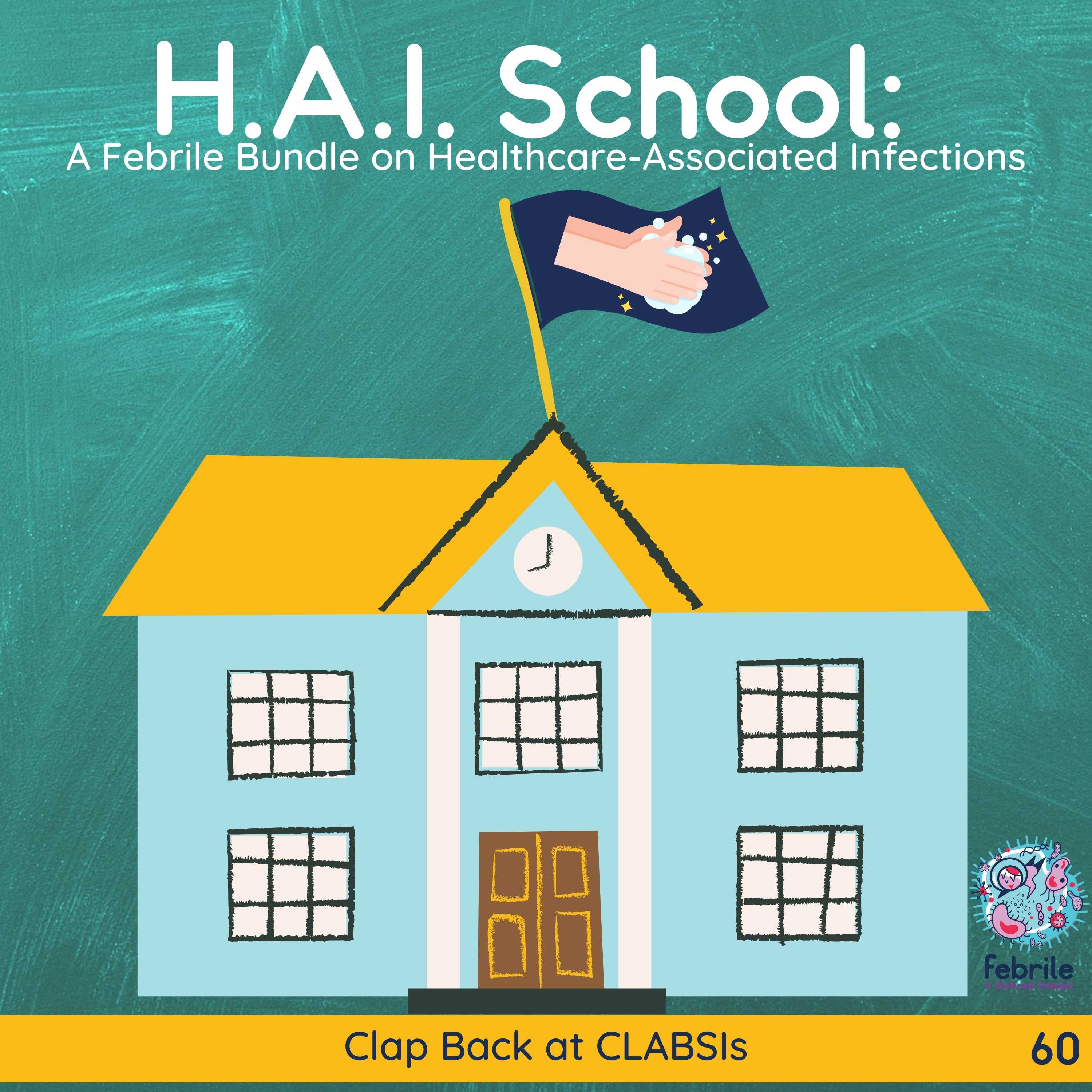Table of Contents
Credits
Hosts: Jeremy Steinbruck, Sara Dong
Guest: Nicholas Gilpin
Writing: Jeremy Steinbruck, Sara Dong
Producing/Editing/Cover Art/Infographics: Sara Dong
Our Guests
Guest Co-Host
Jeremy Steinbruck, MD

Dr. Jeremy Steinbruck completed his undergraduate training at University of Massachusetts Boston. He then earned his medical degree in Dominica at Ross University School of Medicine, where he did clinicals at Far Rockaway NY and Michigan. He completed residency at Carilion Clinic in Roanoke, VA, and he is now back in Michigan for his first year of ID fellowship at Beaumont Royal Oak
Guest Discussant
Nicholas Gilpin, DO

Dr. Nick Gilpin is an infectious disease physician with Beaumont Health, an 8-hospital healthcare system located in southeast Michigan. He currently serves as the Medical Director of Infection Prevention and Epidemiology for Beaumont Royal Oak, a 1,131-bed major academic and referral center with Level I adult trauma and Level II pediatric trauma designations. He is also the Medical Director of Infection Prevention for the Beaumont Health System.
Dr. Gilpin earned his medical degree from Michigan State University College of Osteopathic Medicine in 2006. He completed an internship and residency in internal medicine at Ascension St. John Providence Hospital in Southfield, MI from 2006 to 2009, and he completed his infectious diseases fellowship training at Beaumont Royal Oak in 2011. Dr. Gilpin is currently an assistant professor with the Oakland University William Beaumont School of Medicine and the Michigan State University College of Osteopathic Medicine.
Culture
Nick was excited to start attending concerts and hearing live music again! He plugged a band called Fontaines D.C.
Consult Notes
Consult Q
Patient has elevated leukocytosis and fever in the ICU – concern for sepsis and antibiotic approval?
Key Points
The HAI School Series! HAI = Healthcare Acquired Infections
This episode is #1 of 4 in another Febrile series, this time entitled “HAI School”! This bundle of episodes will discuss some healthcare associated infections (CLABSI, CAUTI, SSI, and VAP). Check out all four episodes (#60-63) to hear them all! The first three are from a team from Beaumont Health, and the fourth episodes features a team from the University of Michigan
Let’s start with the basics! What is a CVC? What is a CLABSI?
- A central venous catheter (CVC) is an intravenous device that terminates at or close to the heart or one of the great vessels. Some examples include:
- Non-tunneled CVCs (subclavian, jugular, femoral)
- Tunneled CVCs
- Dialysis catheters
- Peripherally inserted central catheters (PICCs)
- Implanted ports
- A central line associated blood stream infection (CLABSI) is any infection that originates from or is related to a CVC – but there are two definitions!
- Clinical definition, based on criteria:
- Clinical signs of infection
- No alternate source of bloodstream infection
- Positive blood culture from peripheral vein with any one of the following:
- Catheter tip/segment culture that matches organism grown from percutaneous blood culture
- At least 3 fold higher number of organisms grown from catheter vs peripheral blood culture on simultaneously drawn culture (quantitative blood cultures)
- Growth from catheter-drawn blood culture occurs at least 2 hrs before growth of the same organism from a percutaneously-drawn blood culture (differential time to positivity)
- Although a bit older now, here’s the IDSA Clinical Practice Guidelines for the Diagnosis and Management of Intravascular Catheter-Related Infection: 2009 Update
- NHSN surveillance definition:
- NHSN = CDC’s National Healthcare Safety Network (NHSN), which is a HAI tracking system
- A laboratory confirmed infection where a CVC is in place for >=2 calendar days prior to a positive culture and is also in place the day of or day prior to culture
- Here’s the NHSN document with more details on bloodstream infection events, updated Jan 2023
- Clinical definition, based on criteria:
- Nick explained the surveillance definition, which is for reporting purposes, is simply a positive culture in a patient with a CVC in place – this definition lacks specificity and tends to overestimate incidences of CLABSIs. This can be frustrating as hospitals get financially penalized for this. He emphasizes the importance of considering the source of infection, as linking to another source means it wouldn’t be defined as a primary bloodstream infection
- The difference in clinical definition and the NHSN surveillance perspective is more about quality control and is not used to define treatment
- You can also read more about CLABSI 101 in this slide deck from the CDC, Health Research & Educational Trust (HRET), and STRIVE (States Targeting Reduction in Infections via Engagement)
Diagnosing CLABSI
- As noted above, in the IDSA guidelines, you preferentially will diagnose through 2 mechanisms, either:
- Differential time to positivity: if cultures from catheter are positive earlier by >120 minutes or more before the venipuncture, that strongly suggests that catheter may be source
- Quantitative blood cultures: if >3x as many colonies from line culture as venipuncture, strongly suggests line is the source
- You can culture the catheter tip and if it grows same organisms as from blood, that would also suggest catheter associated infection. That said, cath tip cultures are generally not recommended for CLABSI diagnosis given low predictive value nowadays
- Peterson LR, Smith BA. Nonutility of catheter tip cultures for the diagnosis of central line-associated bloodstream infection. Clin Infect Dis. 2015;60(3):492-493. doi:10.1093/cid/ciu845
- Lai YL, Adjemian J, Ricotta EE, Mathew L, O’Grady NP, Kadri SS. Dwindling Utilization of Central Venous Catheter Tip Cultures: An Analysis of Sampling Trends and Clinical Utility at 128 US Hospitals, 2009-2014. Clin Infect Dis. 2019;69(10):1797-1800. doi:10.1093/cid/ciz218
- These diagnoses and how to collect blood cultures can be controversial, so you need to be aware of what your local lab may or may not be able to do. As Nick explained, not all labs perform differential time positivity or quantitative blood cultures
- He argued that we probably should not be drawing from lines if the lab can’t do differential time to positivity or quantitative blood cultures, because every time you’re accessing that line to draw, you’re introducing the possibility of contamination or increasing the chance that the line could be colonized and become infected
- There’s also emerging evidence that differential time to positivity and quantitative blood cultures might not be as good as we thought, especially for certain organisms such as S.aureus. Plus, if S.aureus in blood, the focus likely should be taking out the catheter – as catheters can also become secondary sources of infection. Nick also discussed how drawing from the line often doesn’t change clinical management of patients (whether that’s Staph where you remove line or E.coli from secondary source)
- The predictive value of differential time to positivity is unclear and it has been shown to have poor performance, particularly for S.aureus (low sensitivity despite high specificity)
- Bouzidi H, Emirian A, Marty A, et al. Differential time to positivity of central and peripheral blood cultures is inaccurate for the diagnosis of Staphylococcus aureus long-term catheter-related sepsis. J Hosp Infect. 2018;99(2):192-199. doi:10.1016/j.jhin.2018.01.010
- Freeman JT, Elinder-Camburn A, McClymont C, et al. Central line-associated bloodstream infections in adult hematology patients with febrile neutropenia: an evaluation of surveillance definitions using differential time to blood culture positivity. Infect Control Hosp Epidemiol. 2013;34(1):89-92. doi:10.1086/668431
What is the pathogenesis of CLABSI?
- There are four major sources of CLABSI
- Based on the route of entry of bacteria:
- Extraluminal: pathogens migrate along external surface of catheter from skin entry site
- Colonization of intracutaneous and intravascular portions of catheter by microorganisms from patient’s skin and occasionally hands of health care workers (on insertion or as result of manipulation)
- Often occurs within 7 days of insertion
- Intraluminal: intraluminal and/or hub contamination, migration along internal surface of catheter
- Particular risk in those with CVCs in place for 2+ weeks and surgical implanted device
- More commonly occurs >7 days, intraluminal colonization
- Secondary BSI: bacteria from another source in the body infects the blood
- Hematogenous seeding from other source
- Infusate contamination: introduction of pathogens from fluids infused through the catheter system
- Extraluminal: pathogens migrate along external surface of catheter from skin entry site
Epidemiology and Impact of CLABSI Infections
- The burden of CLABSI has been changing. In the late 200s and 2010s, CLABSI rates were decreasing – but the impact of COVID infections on hospital systems did show some increases in national CLABSI rates after 2019
- There were ~27,000 CLABSI infections reported in 2021
- To check on the latest data, you can access some info at the CDC website, such as:
- Current National and State HAI Progress Report, where data tables and summaries are available
- National and State Factsheets are available at the Antibiotic Resistance & Patient Safety Portal
- CLABSIs can prolong hospital stays and are an important cause of morbidity and mortality
- Although ICU patients are often studied the most and exposed to more devices, CLABSIs remain common in other settings including hospital wards and outpatient.
What are CLABSI risk factors to consider?
Patient characteristics
- Immunocompromised hosts (transplant recipients, neutropenic or immunodeficiency patients)
- Severe skin burns or other loss of skin integrity
- Malnutrition or protein calorie malnutrition
- Prolonged hospital stay prior to device placement
- Extremes of age
Provider characteristics
- Emergency insertion
- Excessive device manipulation
- Incomplete adherence to safe insertion practices
- Failure to remove unnecessary devices
- Low nurse-to-patient staffing ratio (catheter hub care)
Device characteristics: all intravascular device confer a risk of infection although some carry greater risk than others (nontunneled CVCs, pulmonary artery catheters >> peripheral venous catheters)
- Site of insertion: subclavian site is associated in some studies with lower risk
- Number of lumens
- Duration of catheterization
- Type of catheter material
- Indication for use (total parenteral nutrition, chemotherapy)
Microbiology of CLABSIs
In the past (prior to 1980s), gram negative organisms were predominant causes of nosocomial bloodstream infections – but in recent years, gram positive aerobic organisms (coagulase-negative staphylococci, S.aureus, Enterococcus) and Candida spp are the most prevalent
- Wisplinghoff H, Bischoff T, Tallent SM, Seifert H, Wenzel RP, Edmond MB. Nosocomial bloodstream infections in US hospitals: analysis of 24,179 cases from a prospective nationwide surveillance study [published correction appears in Clin Infect Dis. 2004 Oct 1;39(7):1093] [published correction appears in Clin Infect Dis. 2005 Apr 1;40(7):1077]. Clin Infect Dis. 2004;39(3):309-317. doi:10.1086/421946
- Novosad SA, Fike L, Dudeck MA, et al. Pathogens causing central-line-associated bloodstream infections in acute-care hospitals-United States, 2011-2017. Infect Control Hosp Epidemiol. 2020;41(3):313-319. doi:10.1017/ice.2019.303
- Weiner LM, Webb AK, Limbago B, et al. Antimicrobial-Resistant Pathogens Associated With Healthcare-Associated Infections: Summary of Data Reported to the National Healthcare Safety Network at the Centers for Disease Control and Prevention, 2011-2014. Infect Control Hosp Epidemiol. 2016;37(11):1288-1301. doi:10.1017/ice.2016.174
CLABSI Management
- We mentioned the IDSA guidelines throughout the Consult Notes and the episode: IDSA Clinical Practice Guidelines for the Diagnosis and Management of Intravascular Catheter-Related Infection: 2009 Update
- Don’t forget to check if you have local guidance as well
- In general though, management consists of catheter removal and antibiotic therapy
- We won’t focus on the specific antimicrobial selection here, but the episode did touch on selection of a catheter management strategy. Such as, when should lines be removed?
- Always consider whether the presence of the line is necessary in the first place!
- Catheter removal is generally recommended when:
- Clinical circumstances with sepsis or hemodynamic instability
- Presence of concomitant endocarditis, suppurative thrombophlebitis, metastatic infection
- Persistent bacteremia despite 72 hrs of antibiotics
- Tunnel tract infection with tunneled CVCs or subcutaneous port reservoir infection
- Certain pathogens with high virulence and low likelihood of response to antibiotics alone: S.aureus, Pseudomonas aeruginosa, drug-resistant gram negative bacteria, Candida
Preventing CLABSI
- A bundle is a structured way of improving process of care and patient outcomes using a set of evidence-based interventions at the same time
- The Keystone study published in NEJM demonstrated that a “bundle” of best practices resulted in a large and sustained reduction in rates of CLABSI
- The Keystone Bundle Intervention:
- Hand hygiene prior to catheter insertion
- Use of maximal sterile barrier precautions
- Use of alcohol-containing chlorhexidine for skin antisepsis before insertion
- Avoidance of femoral site
- Removal of unnecessary catheters as soon as able
- Pronovost P, Needham D, Berenholtz S, Sinopoli D, Chu H, Cosgrove S, Sexton B, Hyzy R, Welsh R, Roth G, Bander J, Kepros J, Goeschel C. An intervention to decrease catheter-related bloodstream infections in the ICU. N Engl J Med. 2006 Dec 28;355(26):2725-32. doi: 10.1056/NEJMoa061115. Erratum in: N Engl J Med. 2007 Jun 21;356(25):2660. PMID: 17192537.
- The Keystone Bundle Intervention:
- Check out the newest guidance for preventing healthcare-associated bloodstream infections (from April 2022). Five medical societies joint-release these collaborative recommendations. These provide lists and rationale for practical evidence- and consensus- based practices that acute care hospitals can implement. There are also some “additional approaches” which highlight other considerations.
- Buetti, N., Marschall, J., Drees, M., Fakih, M., Hadaway, L., Maragakis, L., . . . Mermel, L. (2022). Strategies to prevent central line-associated bloodstream infections in acute-care hospitals: 2022 Update. Infection Control & Hospital Epidemiology, 43(5), 553-569. doi:10.1017/ice.2022.87
- As Nick mentioned, here are a few highlights from the updated CLABSI guidance linked above:
- The subclavian vein is recommended as the preferred site for CVC insertion in ICU patients to reduce infectious complications
- Chlorhexidine-containing dressings are now considered “essential practice” in patients over two months of age
Infographics
Goal
Listeners will be able to understand the definition, evaluation, and management of central line associated bloodstream infections.
Learning Objectives
After listening to this episode, listeners will be able to:
- Recognize that CLABSIs can be defined by both clinical and surveillance perspectives
- Understand the recommended approaches to diagnose CLABSI and possible limitations
- Describe strategies to prevent CLABSI
Disclosures
Our guests (Jeremy Steinbruck and Nicholas Gilpin) as well as Febrile podcast and hosts report no relevant financial disclosures
Citation
Gilpin, N., Steinbruck, J., Dong, S. “#60: HAI School: A Febrile Bundle on Healthcare-Associated Infections #1 – Clap Back at CLABSIs”. Febrile: A Cultured Podcast. https://player.captivate.fm/episode/6feb20b2-9dc2-4ad3-b473-744acddb41dc


